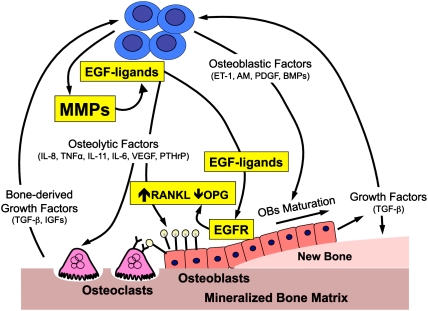Figure 1.
Potential role for MMPs in the bone microenvironment at sites of solid tumor metastases. Tumors secrete (1) osteolytic factors (PTHrP, IL-11, IL-6, IL-8, VEGF, etc.) that stimulate osteoclastic bone resorption either directly or indirectly by increasing the ration of RANKL to OPG, and (2) osteoblastic factors (ET-1, adrenomedullin [AM], platelet-derived growth factor [PDGF] and BMPs) that stimulate osteoblast proliferation and differentiation. The osteoblasts secrete proteins and growth factors (TGF-β and IGFs) that are deposited into mineralized bone matrix and enhance the local microenvironment surrounding the tumor cells. Osteoclastic bone resorption causes release and activation of these proteins to further enhance the local milieu. Studies by Lu et al. (2009) (highlighted here in yellow) indicate that tumor-produced MMPs (MMP-1 and ADAMTS1) may contribute to these interactions by cleaving membrane-bound EGF-like growth factors (EGF ligands: AREG, HB-EGF, and TGF-α) that bind EGFR in osteoblasts to suppress OPG and increase the ratio of RANKL to OPG to favor osteoclastogenesis. Other possible roles for MMPs in this process (not shown in this schematic) include cleavage of collagen at the bone surface to enhance bone resorption mediated by osteolytic factors, cleavage, activation of tumor-expressed RANKL, and activation of other growth factors (such as TGF-β, IGFs, and others) that can further fuel this vicious cycle.

